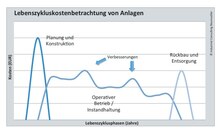Asset management
Asset Management ( English Asset Management ) is in companies that manage the systems . All tangible assets (e.g. machines , industrial plants , infrastructure facilities and buildings ) and parts of the current assets (e.g. spare parts management ) are included as assets . Plant management is called a management system and thus forms a management discipline in the company. Asset management includes investment and cost planning for fixed assets .
General
The fields of activity in plant management can be outlined as follows:
- Planning and new construction of plants
- maintenance
- Reconstruction , expansion and modification
- Decommissioning of plants.
IT programs to support asset management are called “asset management systems” or “enterprise asset management”.
The English term asset management can be confused because it can stand for asset management as well as asset management , especially in German-speaking countries . An exact definition of the plant management is given by the international standard ISO 55000 series . The German-language edition here is referred to as ISO DIN 55000.
ISO 55000
On January 23, 2014 , the International Organization for Standardization published a normative basis for plant management in ISO 55000 (and subsequent figures) . ISO 55000 focuses on all types of assets (including intangibles such as competencies) and forms an important aspect of an " integrated management system " in companies. Demarcating it is Facilities Management for the management of buildings considered.
The basis for this was a British standard. In 2002, a management survey was carried out in various companies in England on the effectiveness of asset management. The result was that the participating decision-makers wanted a common “language”. A specification was developed for this. In the first implementation, two dozen British companies and authorities were involved, while in the second edition in 2008 49 organizations from 15 industries and 10 countries developed a British standard. Germany had not yet participated in this. The focus in the second version was on ensuring the reliability of the systems, above all by observing the organizational framework conditions and controlling all risks over the entire product life cycle of the systems under consideration.
In 2010 an ISO committee decided to develop a global standard for plant management:
- ISO 55000: 2014 overview and principles
- ISO 55001: 2014 requirements for plant management as a "management system"
- ISO 55002: 2014 guideline for the introduction of a plant management system
ISO 55000:
- The first three chapters introduce the terminology of plant management. In addition to basic definitions, this also includes the benefits for the user and an introduction to the plant management system.
ISO 55001:
- The ISO55001: 2014 document provides all the important requirements for the plant management system to be introduced. It forms the basis for an official certification. This is comparable, for example, with the requirements of ISO9001 for a quality management system. The core of the asset management system consists of seven elements:
- Relationships of the company organization and influences
- Leadership, guidelines, strategy and responsibility
- Planning, planning security through risk management
- Support factors such as resources, skills, communication and documentation
- Implementation of operational activities
- Performance measurement of the asset management system
- improvement
ISO 55002:
- Additional information, details on the individual elements and supporting measures are shown in ISO55002: 2014 for the introduction of a plant management system in an organization. The main content is the consideration of possible risks in the various life cycle phases of the assets used to create value.
Use of the ISO55000 series for plant management
Life cycle management
A well-functioning asset management system supports the company throughout the product life cycle of physical assets. Plant-intensive industrial companies benefit from systematic support in the maintenance of plants and buildings.
Risk management
Asset management risk management is seen as an essential component. This requires the identification and control of potential risks through appropriate structures and processes.
Maintenance management
Proactive maintenance management is required in order to fully utilize the technical system effectiveness in the operational phase of operation without using uneconomical resources. The structures and processes are to be designed according to the principles of continuous improvement so that unplanned failures can be prevented. Furthermore, a definition of plant-related maintenance strategies, including the corresponding maintenance and inspection plans, is essential.
practice
In practice, the alignment of the organization to the requirements of the plant management system appears to be advantageous, with the consequence of changed business processes, especially in maintenance.
The first significant change in the company is a standardization of the strategy and processes for handling the systems. The second change is that the plant management system considers the life cycles of the plant park together. The plant management function in the company deals with the initial setup of the systems at the beginning of the life cycle, with the maintenance and with the economic end of the systems. The third change is new functions such as risk identification, communication and information strategy, measurement of costs and performance, execution of audits and a continuous improvement program.
Certification
The first company in German-speaking countries to be certified according to ISO 55001 is the Swiss energy group ALPIQ , which was accompanied by Oxand in setting up the plant management system and certified by Bureau Veritas .
further education
Further training and seminars on asset management are offered by various academies.
Web links
- ISO 55000 website on asset management and ISO55000
- ISO / TC 251 website of the ISO Technical Committee for Asset Management Systems
Individual evidence
- ↑ Alpiq is the first electricity company in Europe to be ISO 55001-certified. (No longer available online.) May 13, 2015, archived from the original on September 16, 2016 ; accessed on September 15, 2016 .
- ↑ Oxand. Asset Management, Aging & Risk Management. In: www.oxand.com. Retrieved September 15, 2016 .
